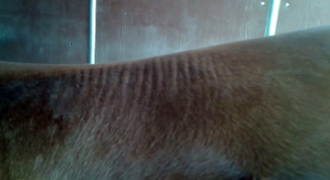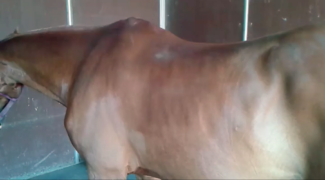Saddle Fit and a Case Study with an Endurance Rider
My interest in endurance riding has come through my association with some top US Endurance Riders – who I am happy to work with in keeping their horses sound over the long distances ridden in these races. I have seen this sport grow from its crazy first decades to the well regulated and exciting sport that it is today. Now, much more so than in the beginning of what has come to be known as “the modern sport of Endurance Riding”, the American Endurance Ride Council (AERC), the governing body of the sport here in the United States and Canada, has matured into an organization that definitely focuses on the well-being of the horses first, and I very much appreciate this as I have unfortunately been witness to how some riders in past years have treated their mounts. That type of abuse and disregard for our amazing equine athletes is a rare occurrence in the sport these days thanks in large part to the AERC.
I talked to a rider and the owner of her horse being ridden a few weeks ago in a 55 mile ride, who has a Schleese saddle, and who said that within a month after the last saddle fitting the horse completely lost its top line and was extremely sore-backed, both over both shoulders (white hair patches) and especially behind the 18th rib. Both claimed that the white hair patches arose because we apparently use synthetic wool to flock our saddles rather than real wool. They said that synthetic wool will eventually ball up and become hard, whereas real wool does not. It was these hard balls of synthetic wool that caused the white patches on the shoulders. A video of what was going on with the horse was included, of which I post a couple of stills (so please excuse the quality).


What endurance riders do on a weekly basis is the absolute extreme of riding. Maintaining the saddle fit of an endurance horse is so tricky because there are so many elements at work: fluid loss, caloric consumption, muscle stress, metabolic rate etc. It stands to reason that the physical changes the horse (and rider) undergo in a 55 mile ride are quite severe. We mustn’t forget that this level of exertion and athleticism is not necessarily a natural condition for the horse – and also that the horse was never meant to be ridden! It takes an extreme maintenance and training program for both horse and rider to be able to achieve these kinds of goals.
Usually white hair is an indication of prior pressure – when the hair follicle is compressed, the lack of blood flow will result in white hair when the new coat comes in. Therefore, the white hair is a result from something prior that may have been eliminated or is still present. The wrinkles on his back likely were caused by the pad used (we recommend only a cotton pad with sheepskin if desired – not foam!)
Regarding the flocking issue: we use only Saddlers Wool which we import directly from England (with expensive shipping and duties). This is the only flocking which has proven itself over decades of use. Different flocking materials are used in various saddle brands, including sheep wool. This tends to compact into clumps and become rock hard as it lacks the synthetic component which gives it buoyancy and the ability to ‘bounce back’. Saddler’s Wool is actually a blend of 60% wool and 40% synthetic and mimics what was used decades ago to stuff saddles.
Often Endurance riding is compared to Formula I racing. During a Formula I race the car goes into the pit stop and gets serviced several times during the race. These extreme sports have the commonality of requiring constant maintenance to ensure peak performance. During Endurance season, the saddle should be checked on almost a monthly basis, or as soon as the rider feels off balance or the horse exhibits the slightest resistance. This indicates it is time to have an evaluation. If it is the rider who is experiencing pain in her back, it is also an indication that the saddle may be out of balance. It could also simply be muscle fatigue because of the amount of riding that goes into a race of this length.
No horse in the wild ever goes 50 miles in 7 hours, which is the average speed that includes vet checks and mandatory holds. In the wild, the farthest horses have ever been observed to travel in a day is nearly 20 miles, and that’s not often. Plus, they graze the almost the entire way. At an endurance ride in northern California a few months ago, all the 50 mile horses were weighed before and after the ride. That particular endurance ride is famous for having the steepest and the most hills of any 50 mile ride. It is typically extremely hot. The average weight loss of the 80+ endurance horses competing that day was 50 pounds—approximately 1 pound/mile. So yes, endurance horses definitely change shape during ride day. The girth will be tight at the start and loose by the finish. There is nothing natural about the distance and speed horses go during endurance rides – or about any other performance sport we do with our horses. It takes years of conditioning a horse that is “born” for the sport in order to succeed.
I’m actually very sad to see how this horse looks. He is so thin and has very poor muscle definition – a huge change in such a short time. Based on some of the pictures I have seen of endurance riders, many horses are ridden with their heads up and their backs down, which exacerbates this type of result over these distances.
The video of this horse looks like it was taken immediately after such an immensely taxing ride, and you can see how thin he looks. It is the rider’s responsibility to keep the horse happy and pain free especially during conditioning and competition. As an Endurance Rider this responsibility is increased tenfold given the demands of the sport.
